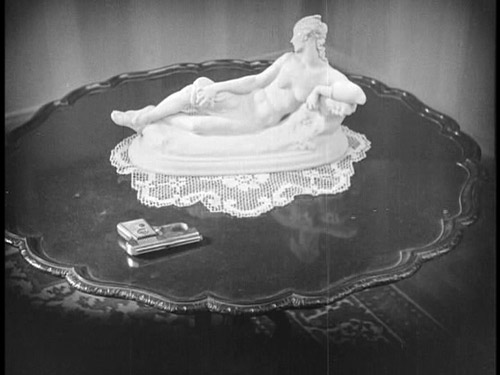
© 2012 William Ahearn
Time has washed up more than some lost films as regards the life of Fritz Lang. Recent research has cast a new light on Lang’s first marriage and while the private lives of screen personalities rarely interest me, in this case it has already affected how his films are being viewed by at least by one recent biographer. The events concerning his first wife occurred either in the post-production of “Das wandernde Bild” or “Vier um die Frau” or the pre-production of “Der müde Tod,” although even that is a guess.
Lang’s first wife was named Lisa Rosenthal although no source is absolutely positive about that and she is described – in some accounts – as a “Russian from Vilnius.” Little else is known about her and it is not her life that is fascinating as much as it is her death. One reference that I found was in Robert A. Armour’s Fritz Lang, published by Twayne Publishers in 1977. Armour wrote, “[Fritz] Lang divorced his first wife and married [Thea] von Harbou.”
Lang didn’t divorce Lisa Rosenthal. Rosenthal died of a gunshot wound to the chest and therein hangs a tale that Lang left behind when he fled from Germany in 1933. The story is told in Patrick McGilligan’s Fritz Lang: The Nature of the Beast and the recap goes something like this: Thea von Harbou was married to actor Rudolf Klien-Rogge and when her affair with Lang – that was no secret to the film community – heated up, she moved out of her home with Klien-Rogge and moved into the same apartment building as Fritz Lang. One day Lisa Rosenthal comes home unexpectedly and finds Lang and Harbou engaged in “violent petting,” as Lang described it later, on the sofa. Shortly thereafter, Rosenthal is found dead in the bathtub from a gunshot to the chest delivered by Lang’s WWI sidearm that he kept as a memento. Phone calls were made but it wasn’t the police that were called immediately and suspicions flew. Harbou and Lang swore that Rosenthal shot herself and there was little the police could do and Lang and Harbou were charged with denial of assistance although that charge was soon dropped.
Suspicion fell on Lang that he had shot Lisa Rosenthal and émigrés brought that story to Hollywood years later although only in hushed tones and never when Lang was within earshot. No one has ever suggested that Thea von Harbou was in any way involved although obviously, if Lang killed his wife, von Harbou was some sort of accomplice even if only after-the-fact. What’s interesting in all of this is that so little is known about von Harbou.
There is talk that after “Der müde Tod” was finished Lang was committed to an insane asylum for a brief stay. Lang would mention in interviews that he visited insane asylums as a part of his research. The truth is lost to time. At this point all that remains is stories and gossip. Patrick McGilligan wrote, “No record of an inquest – no record, even, of Lisa Rosenthal’s death – could be found in the course of research for [Fritz Lang: The Nature of the Beast].” Studio executives – including Erich Pommer – showed up at the scene and much like Hollywood moguls they influenced and cajoled the police to protect their star.
Frederick Ott in The Films of Fritz Lang describes the death of the unnamed Frau Lang as an “apparent” suicide. Lotte Eisner in Fritz Lang states that Lang’s wife “committed suicide” and wrote in her biography Ich hatte einst ein schones Vaterland: Memoiren, published in 1984 and never translated into English: “[Lisa Rosenthal] then went into the bedroom [sic] and shot herself.”
McGilligan states: “Perhaps suicide was such a familiar condition in his mind that it leapt to Fritz Lang’s tongue unbidden when the police arrived at his apartment on that fateful day, asking him to explain the inexplicable.” McGilligan bases this assumption on the content of Lang’s work stating that: “From the first film to the last, guilt, complicity, false accusation, irredeemable crime, inadvertent killings, and suicide haunt Lang’s work.” All of that is true except for the “guilt” and McGilligan seems to skip over the murders in Lang’s films. What “leapt to Fritz Lang’s tongue” implies that something else had occurred and there is only one other possibility. McGilligan then writes: “After the death of Lisa Rosenthal, the litany [of suicides in Lang’s films] is compelling.” McGilligan then lists the suicides in Lang’s films and describes them as “unmistakable thematic statements.”
According to one study of Weimar films, the three major themes in the top 25% of the films were guilt [about starting WWI], generational issues and suicide. Suicide was common in the films of Weimar as it would be later in films in France and Asia. It began to wane in the years of the Hays Code in the United States.
To attempt to solve whether Lisa Rosenthal’s death was murder or suicide by the content of the films Fritz Lang made after the event – especially the Hollywood films where Lang rarely had influence over the script – doesn’t make for a compelling case. Especially since a list of murders in Lang’s films would run even longer than a list of suicides.
Then again, a pistol being within grasping range shows up in Lang’s films quite often. McGilligan has produced an excellent biography of Lang and presents research that helps to understand the times that Lang lived. Where the author isn’t as impressive is in his understanding of the films and filmmaking as an art (eg, his description of the ending of “Spione” is inaccurate). There is no Hollywood ending to this story, no convenient set of symbols pointing to a resolution. There is only a dead woman with a gunshot chest wound bleeding in a bathtub and a lot of unanswered questions. That’s the end of the story.
